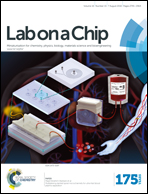Acoustically-driven thread-based tuneable gradient generators†
Abstract
Thread-based microfluidics offer a simple, easy to use, low-cost, disposable and biodegradable alternative to conventional microfluidic systems. While it has recently been shown that such thread networks facilitate manipulation of fluid samples including mixing, flow splitting and the formation of concentration gradients, the passive capillary transport of fluid through the thread does not allow for precise control due to the random orientation of cellulose fibres that make up the thread, nor does it permit dynamic manipulation of the flow. Here, we demonstrate the use of high frequency sound waves driven from a chip-scale device that drives rapid, precise and uniform convective transport through the thread network. In particular, we show that it is not only possible to generate a stable and continuous concentration gradient in a serial dilution and recombination network, but also one that can be dynamically tuned, which cannot be achieved solely with passive capillary transport. Additionally, we show a proof-of-concept in which such spatiotemporal gradient generation can be achieved with the entire thread network embedded in a three-dimensional hydrogel construct to more closely mimic the in vivo tissue microenvironment in microfluidic chemotaxis studies and cell culture systems, which is then employed to demonstrate the effect of such gradients on the proliferation of cells within the hydrogel.


 Please wait while we load your content...
Please wait while we load your content...